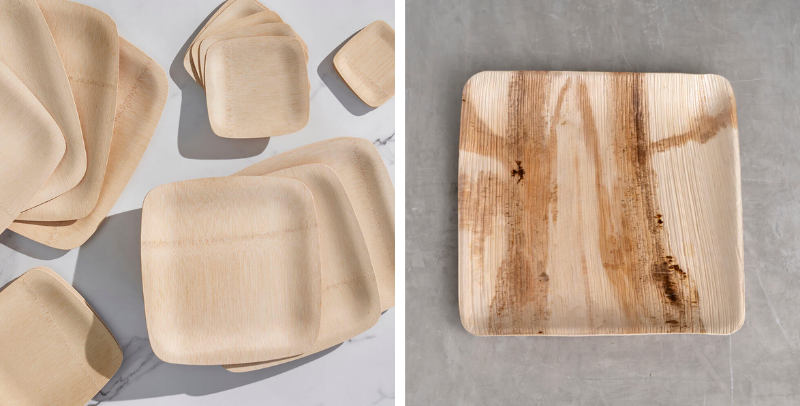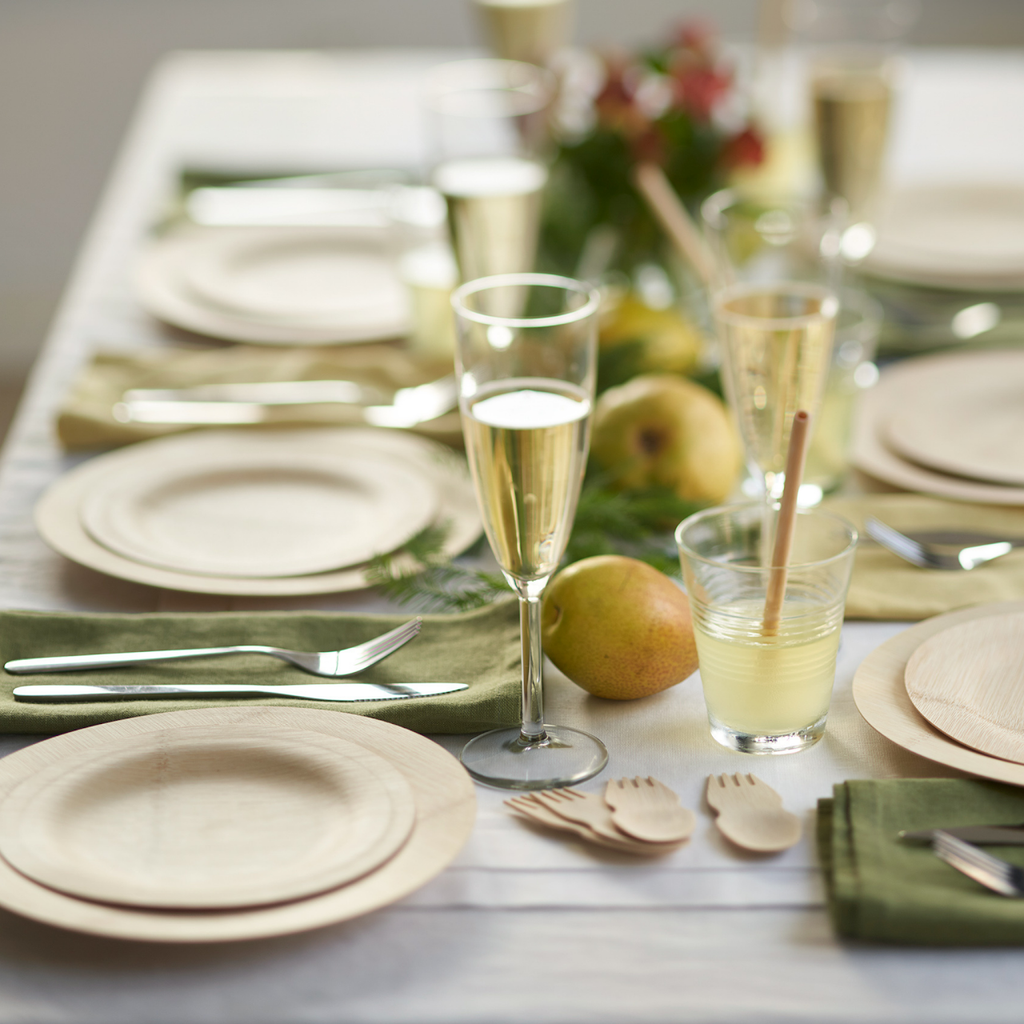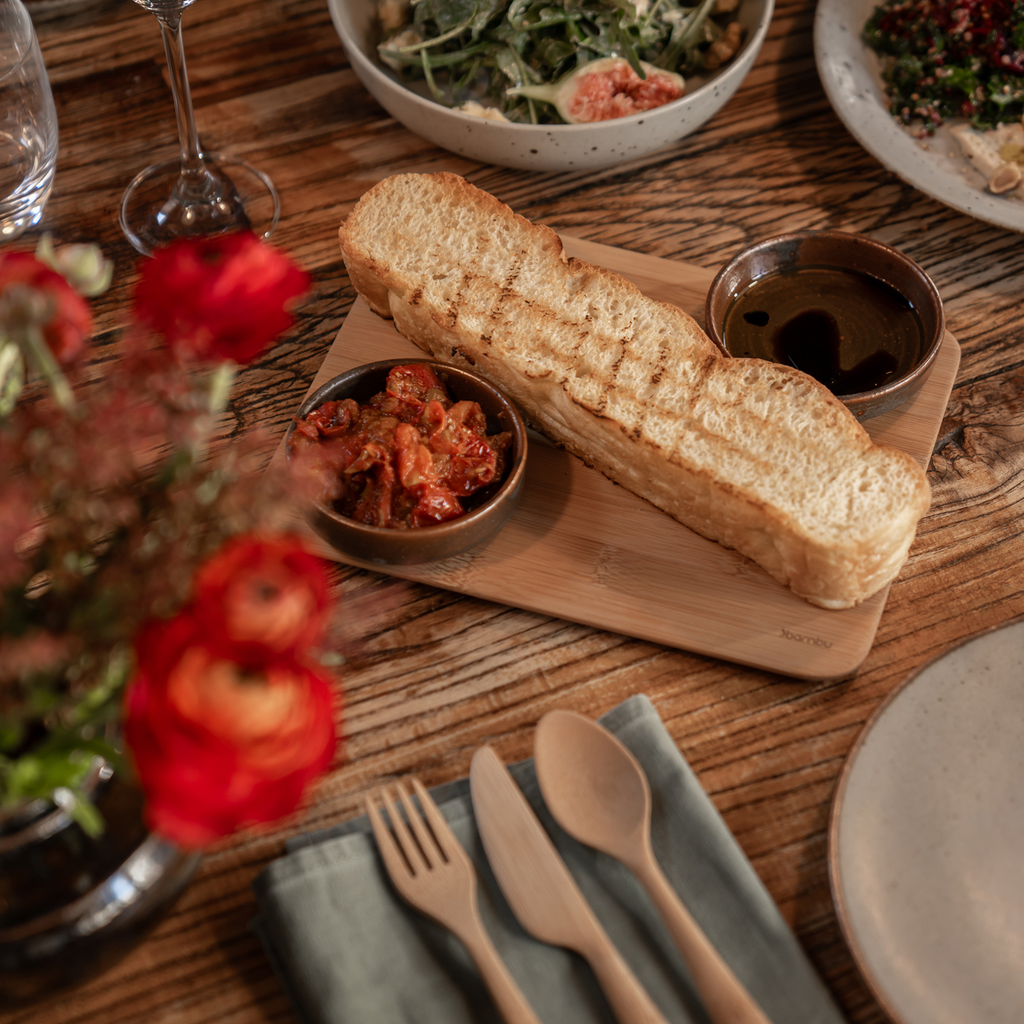Planning to use compostable plates for your wedding, but not sure which to choose? Both favored for their natural look and eco-friendly nature, bamboo plates and palm leaf plates are two of the most popular options. Discover the pros and cons of both to find the right fit for your celebration.
Whether it’s a certain color pallet or a theme, the items that make up your tabletop spread can help tie the look of your celebration together. And naturally, you’ll want a dependable dinnerware choice that effortlessly handles any and all types of foods without causing a mess.
Choosing compostable plates for wedding receptions or cocktail hours shouldn’t take away from your event. In fact, they should enhance it. But how to find your perfect plate? With a breakdown of factors like aesthetics, durability, and disposal, this guide will help you decide!
It should be noted that even compostable plates of the same material can vary greatly based on the company that makes them. It depends on the material quality, production process, how the plate is finished, and so much more. While these guidelines offer a fantastic starting point, it’s always best to do additional research and look for a reputable business that has certifications to back up their quality and sustainability claims.
Aesthetics: Which Option Matches Your Wedding?
Bamboo and palm leaf plates are both made of natural materials. But they have very different characteristics when it comes to look and feel. Here’s what you can expect:
Bamboo Plates
Disposable bamboo plates are made from thinly cut sheets of finely cut bamboo, often known as veneer. The subtle grain of the bamboo plant results in uniform color for every bamboo plate. Even when you order large quantities of plates that are made with different trees. It’s uncommon for bamboo to have any noticeable color variation, which is ideal if you want a refined yet natural look. From plate to plate, every bamboo plate has a consistent texture, tone, and grain.
The natural color of bamboo is a light wood tone with a lovely golden luster. It’s a great option for nearly any color scheme, and works well with patterns, too. With an even surface and symmetrical shape, bamboo plates can be dressed up for indoor, white tablecloth occasions. And they’ll also look right at home in rustic or outdoor settings like backyard brunches and barn weddings. Whether you’re planning for a romantic, bohemian style, or prefer a modern look, bamboo plates will fit the occasion.
Palm Leaf Plates
Prefer a less polished, more free spirited aesthetic? When it comes to palm leaf plates, the look and feel of each plate is more uncertain. Because the plates are made from fallen leaves with variable textures and colors, palm leaf plates can vary greatly from plate to plate, causing a more unfinished look. When setting a table for a formal event like a wedding, palm leaf plates simply cannot offer a predictable place setting from seat to seat. It’s common for these plates to feature streaks of darker colors throughout them. Now, that may appeal to some, but many find that the distracting colors take away from other table elements.
When it comes to plate texture, palm leaf plates have uneven edges and natural ridges due to the material they’re made of. This can make cutting tougher foods challenging. And it makes evenly stacking the plates nearly impossible. In a buffet setup, this can cause uneven stacks of plates to wobble or topple over. When creating table settings, the uneven shape and edges of palm leaf plates will make it challenging to create a uniform look. While palm leaf plates could work for more rustic events, they may clash with other wedding aesthetics.
Durability: Palm Leaf Plates Vs Bamboo Plates
The last thing you want is a broken plate to cause a spill on a guest’s (or your own) wedding attire. Having durable dinnerware that you can trust to last through the reception is essential. Here’s how these two disposable wedding plate options hold up.
Bamboo Wedding Plates
It’s a little known fact that bamboo is the strongest woody plant on the planet. The long fiber of bamboo makes it an extremely durable plate that’s also still lightweight. Bamboo plates are typically created with a food-grade, non-toxic adhesive that adds another layer to their durability. You can expect a plate that’s thicker than a typical paper plate, sometimes even causing them to be mistaken for a reusable option. Bamboo plates easily hold messy, wet foods, and you can enjoy your mean assured that your plate won’t buckle under the weight of pasta salad (or even a healthy serving of ribs).
Palm Leaf Plates
Palm leaf plates are also praised for their superior durability in comparison to paper plates. The thickness of palm leaf means that you won’t have to worry about the plates bending or breaking. However, you’ll need to watch out when serving hot or wet foods. Palm leaf plates are molded into shape with steam. This can lead to easier absorption of liquid. And in some cases, palm leaf plates can become weak and even begin to leak when subject to hot and wet foods.
Palm and Bamboo Plate Disposal: What To Do When The Party’s Over
Both bamboo and palm leaf are natural, renewable materials. Unlike paper or plastic plates, they are biodegradable and compostable (in most cases). However, double check the brand of plate you plan on purchasing for specific disposal instructions. To be sure that the plate is truly compostable, look for a certification from the Compost Manufacturer Alliance (CMA) or Biodegradable Products Institute (BPI). And always ensure that palm leaf or bamboo plates are suitable for the composting service you’ll be using. Bamboo plates and some palm leaf plates can be composted in a backyard compost setting, but not all commercial compost facilities accept natural plates.
Sustainability: What Are The Most Eco-Friendly Wedding Plates?
Weddings and big events often have a large carbon footprint. So if you’re trying to celebrate more sustainably, you’re not alone! Many couples are searching for ways to reduce the impact of their wedding. And dinnerware is a big part of the puzzle.
Choosing a compostable, disposable option is a fantastic choice, but sustainability really starts at the source.
Both bamboo and palm leaf plants are natural, renewable materials. Bamboo is the fastest growing woody plant in the world, and when its stalk is cut, the plant simply continues to grown on. This eliminates deforestation, particularly when the bamboo comes from a sustainably managed wild forest. Naturally resistant to pests, the bamboo plant is typically grown without pesticides or chemicals. And once the bamboo is harvested, it’s cut into thin slices of veneer. Then, it’s hand finished to ensure a completely smooth finish. Finally, bamboo plates from Bambu are passed through a UV machine to eliminate any final traces of bacteria. When you choose compostable plates made from certified organic bamboo, you can be sure that your plates are bacteria, chemical and pesticide free.
The leaves for palm leaf plants are harvested from the Areca palm tree. This tree sheds its leaves onto the ground several times per year, and the fallen leaves are then picked from the dirt to be processed. Many palm leaf plate manufacturers use a natural blend of water and turmeric to cleanse the leaves before they are dried. Once the palm leaves are dry, they are molded into shape using a hot steam press. While palm leaf plates are made in a sustainable manner, there are no certified organic palm leaf plates on the market. And, it’s unclear how well this process works to remove bacteria from the plates before they’re shipped for use.
The Bottom Line: Bamboo Plates Vs. Palm Leaf
Both bamboo and palm leaf plates are a natural and compostable alternative to paper or plastic plates. And they can both be microwaved at low temperatures. But when it comes to durability for a range of foods, bamboo is a more reliable option. Due to its superior strength and ability to handle wet foods, you can trust disposable bamboo plates to last from cocktail hour to the cake cutting without issue. When it comes to looks, palm leaf plates might be a good fit if you prefer a more casual, eclectic look. If you prefer a consistent look for your tabletop spread, bamboo is an ideal choice. While palm leaf plates often feature unsightly dark streaks, the warm sheen of bamboo will carry over seamlessly from plate to plate.
Your wedding deserves the best! Shop the only plates that are made with certified organic bamboo and compost approved.
Go to our Wedding Inspiration page for more tips and info about wedding and event planning.





